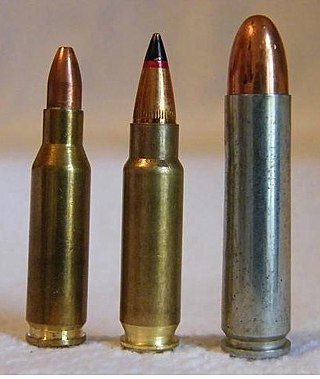In NATO, a standardization agreement defines processes, procedures, terms, and conditions for common military or technical procedures or equipment between the member countries of the alliance. Each NATO state ratifies a STANAG and implements it within its own military. The purpose is to provide common operational and administrative procedures and logistics, so one member nation's military may use the stores and support of another member's military. STANAGs also form the basis for technical interoperability between a wide variety of communication and information systems (CIS) essential for NATO and Allied operations. The Allied Data Publication 34 (ADatP-34) NATO Interoperability Standards and Profiles which is covered by STANAG 5524, maintains a catalogue of relevant information and communication technology standards.
Nammo, short for Nordic Ammunition Company, is a Norwegian-Finnish aerospace and defence group specialized in production of ammunition, rocket engines and space applications. The company has subsidiaries in Finland, Germany, Norway, Sweden, Switzerland, Spain, the United Kingdom, the Republic of Ireland, and the United States. The company ownership is evenly split between the Norwegian government and the Finnish defence company Patria. The company has its headquarters in Raufoss, Norway.

.22 caliber, or 5.6 mm, refers to a common firearms bore diameter of 0.22 inch (5.6 mm) in both rimfire and centerfire cartridges.
The 6.5×25mm CBJ is a firearm cartridge designed by CBJ Tech AB, a Swedish weapon development company based in Kungsbacka, for its CBJ-MS submachine gun/personal defence weapon.
NATO AEP-55 STANAG 4569 is a NATO Standardization Agreement covering the standards for the "Protection Levels for Occupants of Logistic and Light Armored Vehicles".

The .224 Boz cartridge was developed in the late 1990s, designed as a candidate replacement cartridge for adoption as the standardized NATO ("STANAG") Personal defense weapon PDW round, originally solicited to replace the longstanding NATO standard (STANAG) 9×19mm Parabellum. It was going to be the British entry, to be evaluated alongside the Belgian FN 5.7x28mm and the German HK 4.6×30mm armor-piercing cartridges. The solicitation would also seek to find, test and standardize a PDW cartridge capable of, at the minimum, defeating the Collaborative Research Into Small Arms Technology (CRISAT) body armour of the time.

SNT Motiv Co., Ltd. is a South Korean firearms and auto parts manufacturer founded in 1981. Its firearms equip most frontline units of the Republic of Korea Armed Forces.

The 4.6×30mm cartridge is a small-caliber, high-velocity, smokeless powder, rebated, bottleneck, centerfire cartridge designed for personal defense weapons (PDW) developed by German armament manufacturer Heckler & Koch (HK) in 1999. It was designed primarily for the MP7 PDW to minimize weight and recoil while increasing body armor penetration. It features a pointed, steel-core, brass-jacketed bullet.

The FN 5.7×28mm is a small-caliber, high-velocity, smokeless-powder, rebated, non-tapered, bottleneck, centerfire cartridge designed for pistols and personal defense weapons (PDW) uses, manufactured by FN Herstal. It is similar in length to the .22 WMR and .22 Hornet. Unlike many new cartridges, it has no parent case; the complete package was developed from scratch by FN.
This page is based on this
Wikipedia article Text is available under the
CC BY-SA 4.0 license; additional terms may apply.
Images, videos and audio are available under their respective licenses.










